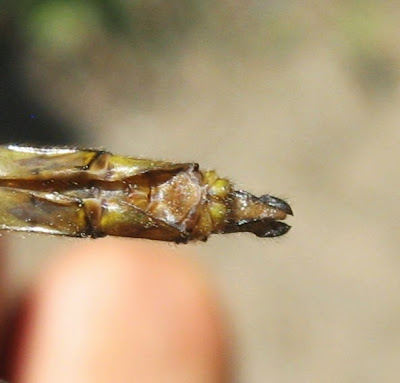Like most of its Baskettail and Emerald cousins (family Corduliidae) the Stygian Shadowdragon is a medium sized dragonfly about 50 mm in length. In contrast to its sun-loving relatives and odonates in general this dragonfly is crepuscular, coming out to forage over fast-flowing water at dusk and flying into the early hours of the evening.
Due to its nature the Stygian Shadowdragon is seldom encountered and has earned an undeserved reputation for being rare, but the numbers of exuviae found on rocks rising out of the water and bridge piers indicate otherwise. True to form this teneral male was spotted hanging out in a shady spot.

A better look at Neurocordulia yamaskanensis – needless to say the dragonfly was handled with great care. It wasn't fresh out of its larval exoskeleton, but it's not fully mature either, so it was studied for as short a time as possible to avoid damaging its relatively soft body.
This is not a boldly colored insect, with pale yellow markings on the thorax and abdomen, and an amber tint at the base of the wings, looking much like a faded Baskettail.
Lateral, oblique and ventral aspects of the terminal appendages. The Broad-Tailed Shadowdragon (Neurocordulia michaeli) would have a tiny spine on the ventral side of the cerci.
A feature that stood out immediately in the field but not mentioned in my books is that the cerci are somewhat flattened (unlike the cerci of, for instance, a Common Baskettail) and have a bit of a twist to them.
In hindsight the Stygian Shadowdragon depicted above was not the first encounter. On May 31st, 2014 during a tour of the Point southeast of town we had observed what looked like a washed-out teneral male Baskettail. I was unable to approach closely enough to capture or photograph the dragonfly, but
Jason King had acquired an image and the mystery dragonfly proved to be a Stygian Shadowdragon.
Two sightings within a few days suggested the Stygian Shadowdragons were molting and transforming into adults, and this prompted a hunt for exuviae and/or emerging tenerals.
The exuviae, collected on June 03, 2014, were found approximately 2 meters from the water (that includes horizontal and vertical distance) on the pier of a bridge crossing the Moira River at Louisa Steet in Tweed, Ontario. The first sets of images are not the best, they were taken underneath the pier on a cloudy day using the flash.
Length is about 23 mm give or take.
Exuviae Number 1
Exuviae Number 2
The following day was sunny, making it possible to acquire sharper images. These macros of Exuviae Number 2 illustrate the critera used to determine that the exoskeleton once belonged to Neurocordulia yamaskanensis – the deep, rounded crenations on the labial palps ...
... rounded dorsal spines pointing backwards ...
... divergent lateral spines on S8, and lateral spines on S9 that do not extend past the cerci.
On June 05, 2014 another exuviae about 25 mm long was discovered on the pier of the old railroad (now the trans-Canada Trail) bridge spanning the Moira River, about 10 meters from the shoreline.
Identification of odonate naiads and exuviae can be tricky and isn't covered further than the family level in field guides. The exuviae were identified to species level with this
Key to Larvae of Michigan Corduliidae.

























